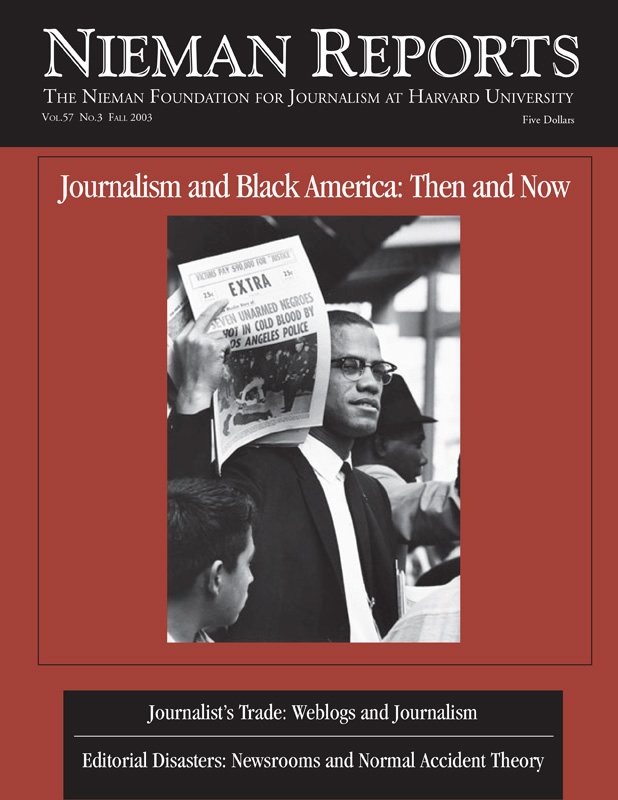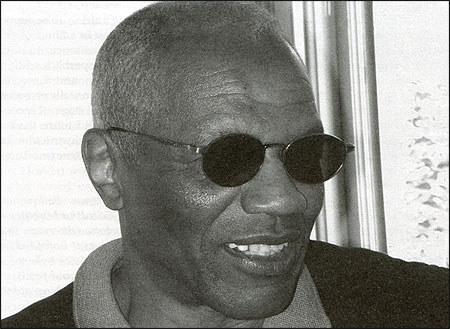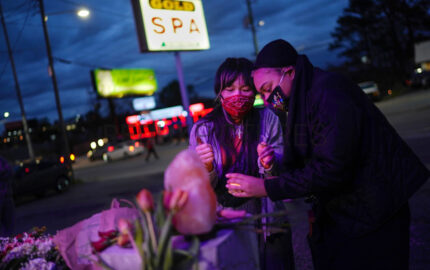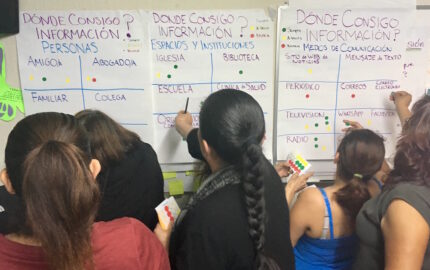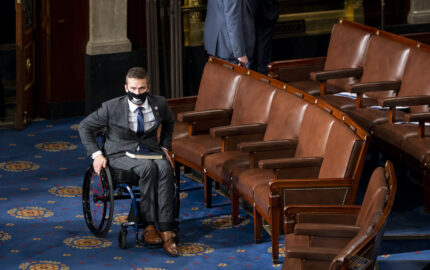It was an era unlike any other. It came on the heels of the civil rights movement. First came the urban explosions of the mid-1960’s known as “the riots” and then the calls of “Black Power” and the emergence of “the black consciousness movement.” What took place became known as “the black revolution,” and it was a revolution that changed the country and changed the way the media covered issues involving race in this country.
White journalists, many of whom risked their lives and made their careers, covered the civil rights movement. But as civil rights morphed into Black Power, white journalists could not cover all aspects of the emerging story. Suddenly, white editors hired black journalists who had been repeatedly rejected from scores of newspapers.
The Maynard Institute History Project and its Robert C. Maynard Oral History Collection document and preserve the stories of those courageous African-American journalists who broke into general circulation media during the turbulent 1960’s and 1970’s. The two-part project includes The Caldwell Journals. Written by former New York Times reporter and Daily News columnist Earl Caldwell, the serialized account of those stormy years captures the dramatic tale of the journalist behind the words, the journalist as player. The Robert C. Maynard Oral History Collection captures the voices of journalists telling their own stories. Those interviewed include Ed Bradley, of “60 Minutes,” Charlayne Hunter-Gault, of CNN, Institute cofounder Nancy Maynard, and Earl Caldwell. The Institute also plans to document the stories of journalists from other ethnic groups who broke general circulation barriers in the news media.
This collection explicitly documents—for the first time—the unique contributions of African-American journalists, and it stands as a rebuttal to those who claim that diversity is at the root of a decline in the quality of journalism. Hearing and reading what can be found in this archive makes it abundantly clear that it was white journalists who reported on the civil rights movement (except for those reporters from the black press), while it was mainly black reporters who covered this other era—Black Power, black consciousness, and the black revolution. In fact, this became the only time that mainstream media put an important story entirely in the hands of black reporters. That was a decision borne from necessity. With cries of “white reporter out,” black journalists were the only ones who were able to get the story.
Covering the Black Power Story
As Caldwell explains in his journals, the beginning of the change happened on the day Malcolm X was assassinated. “In Harlem on the Sunday that Malcolm X was killed, two reporters were right up front in the Audubon Ballroom, so close to the podium that when the shooting started, they had to dive to the floor for cover,” Caldwell wrote.
“Being there changed a lot for the two journalists. But how it happened that Stan Scott and Gene Simpson got into the ballroom at all that afternoon played a large part in ushering in a whole new era for black reporters. In the epilogue of ‘The Autobiography of Malcolm X,’ the author, Alex Haley, explained that on the day of his assassination Malcolm X specifically ordered that no press be allowed inside the ballroom. When Scott and Simpson arrived for Malcolm’s meeting they had their press credentials in clear view.
“At the door, they were greeted by one of Malcolm’s lieutenants. ‘No press allowed,’ he told them. Stunned, the two pondered the ‘no press’ edict until a suggestion was volunteered.
Malcolm’s aide pointed to their press credentials. ‘Put ‘em in your pocket,’ he said. They complied. Once they did that, they were told, ‘As black citizens, you can go on in.’
“Scott was covering that day for the UPI news service; Simpson was with WMCA radio. After the kind of exclusive they reported that day, there were significant rewards to be reaped. Scott was enticed to leave UPI and join WINS radio, then New York’s premier all-news station. Simpson was lured to television, first as a writer at the local CBS station in New York and then to WABC as an on-camera reporter.” (For the rest of the story go to www.maynardije.org and click on The Caldwell Journals.)
These are the important stories at the core of the project—stories of black reporters who were at the center of this revolution. Until now, black reporters who covered this era rarely had opportunities to tell their stories in books, in documentaries, and in magazine articles. As a result a large part of history remains untold.
Another story largely ignored in books that document the news media is the genesis of shield laws. As the Black Panthers rose in prominence, the Federal Bureau of Investigation and the Department of Justice began to demand that black reporters “spy” on the Black Panthers. They did this by demanding notes, tape recordings, and other information gathered by reporters. Caldwell, who was then with The New York Times in its San Francisco bureau, was a particular target. There was an effort to force him to appear before a federal grand jury investigating the Panthers.
In response, black reporters across the nation organized and led a legal fight against the government. Bay Area black journalists began publishing their own newspaper, “Ball and Chain Review,” to publicize this case and their actions. They convened the first national gathering of black reporters. And they obtained then Stanford University professor and noted Constitutional lawyer Anthony Amsterdam to argue their case. That battle reached the Supreme Court, where the government won. However, the case created the rationale for state-enacted “shield laws,” which protect reporters’ notes from government seizure.
The lawsuit is well known. But the story behind it—the way black reporters organized to fight for their rights to be reporters who covered the black community and didn’t “spy” for the FBI—has largely been ignored. These tapes and the History Project remind us of these journalists’ contributions to our craft.
Dori J. Maynard, a 1993 Nieman Fellow, is president of the Robert C. Maynard Institute for Journalism Education. Prior to being named president in January 2001, she directed the History Project. She also heads the Fault Lines Project, a framework that helps journalists more accurately cover their communities, and is coauthor of “Letters to My Children,” a compilation of nationally syndicated columns by her late father, Robert C. Maynard, a 1966 Nieman Fellow.
White journalists, many of whom risked their lives and made their careers, covered the civil rights movement. But as civil rights morphed into Black Power, white journalists could not cover all aspects of the emerging story. Suddenly, white editors hired black journalists who had been repeatedly rejected from scores of newspapers.
The Maynard Institute History Project and its Robert C. Maynard Oral History Collection document and preserve the stories of those courageous African-American journalists who broke into general circulation media during the turbulent 1960’s and 1970’s. The two-part project includes The Caldwell Journals. Written by former New York Times reporter and Daily News columnist Earl Caldwell, the serialized account of those stormy years captures the dramatic tale of the journalist behind the words, the journalist as player. The Robert C. Maynard Oral History Collection captures the voices of journalists telling their own stories. Those interviewed include Ed Bradley, of “60 Minutes,” Charlayne Hunter-Gault, of CNN, Institute cofounder Nancy Maynard, and Earl Caldwell. The Institute also plans to document the stories of journalists from other ethnic groups who broke general circulation barriers in the news media.
This collection explicitly documents—for the first time—the unique contributions of African-American journalists, and it stands as a rebuttal to those who claim that diversity is at the root of a decline in the quality of journalism. Hearing and reading what can be found in this archive makes it abundantly clear that it was white journalists who reported on the civil rights movement (except for those reporters from the black press), while it was mainly black reporters who covered this other era—Black Power, black consciousness, and the black revolution. In fact, this became the only time that mainstream media put an important story entirely in the hands of black reporters. That was a decision borne from necessity. With cries of “white reporter out,” black journalists were the only ones who were able to get the story.
Covering the Black Power Story
As Caldwell explains in his journals, the beginning of the change happened on the day Malcolm X was assassinated. “In Harlem on the Sunday that Malcolm X was killed, two reporters were right up front in the Audubon Ballroom, so close to the podium that when the shooting started, they had to dive to the floor for cover,” Caldwell wrote.
“Being there changed a lot for the two journalists. But how it happened that Stan Scott and Gene Simpson got into the ballroom at all that afternoon played a large part in ushering in a whole new era for black reporters. In the epilogue of ‘The Autobiography of Malcolm X,’ the author, Alex Haley, explained that on the day of his assassination Malcolm X specifically ordered that no press be allowed inside the ballroom. When Scott and Simpson arrived for Malcolm’s meeting they had their press credentials in clear view.
“At the door, they were greeted by one of Malcolm’s lieutenants. ‘No press allowed,’ he told them. Stunned, the two pondered the ‘no press’ edict until a suggestion was volunteered.
Malcolm’s aide pointed to their press credentials. ‘Put ‘em in your pocket,’ he said. They complied. Once they did that, they were told, ‘As black citizens, you can go on in.’
“Scott was covering that day for the UPI news service; Simpson was with WMCA radio. After the kind of exclusive they reported that day, there were significant rewards to be reaped. Scott was enticed to leave UPI and join WINS radio, then New York’s premier all-news station. Simpson was lured to television, first as a writer at the local CBS station in New York and then to WABC as an on-camera reporter.” (For the rest of the story go to www.maynardije.org and click on The Caldwell Journals.)
These are the important stories at the core of the project—stories of black reporters who were at the center of this revolution. Until now, black reporters who covered this era rarely had opportunities to tell their stories in books, in documentaries, and in magazine articles. As a result a large part of history remains untold.
Another story largely ignored in books that document the news media is the genesis of shield laws. As the Black Panthers rose in prominence, the Federal Bureau of Investigation and the Department of Justice began to demand that black reporters “spy” on the Black Panthers. They did this by demanding notes, tape recordings, and other information gathered by reporters. Caldwell, who was then with The New York Times in its San Francisco bureau, was a particular target. There was an effort to force him to appear before a federal grand jury investigating the Panthers.
In response, black reporters across the nation organized and led a legal fight against the government. Bay Area black journalists began publishing their own newspaper, “Ball and Chain Review,” to publicize this case and their actions. They convened the first national gathering of black reporters. And they obtained then Stanford University professor and noted Constitutional lawyer Anthony Amsterdam to argue their case. That battle reached the Supreme Court, where the government won. However, the case created the rationale for state-enacted “shield laws,” which protect reporters’ notes from government seizure.
The lawsuit is well known. But the story behind it—the way black reporters organized to fight for their rights to be reporters who covered the black community and didn’t “spy” for the FBI—has largely been ignored. These tapes and the History Project remind us of these journalists’ contributions to our craft.
Dori J. Maynard, a 1993 Nieman Fellow, is president of the Robert C. Maynard Institute for Journalism Education. Prior to being named president in January 2001, she directed the History Project. She also heads the Fault Lines Project, a framework that helps journalists more accurately cover their communities, and is coauthor of “Letters to My Children,” a compilation of nationally syndicated columns by her late father, Robert C. Maynard, a 1966 Nieman Fellow.
